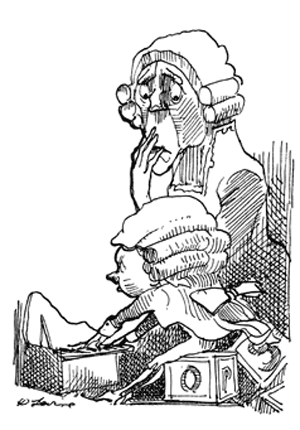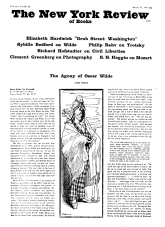As far back as 1938 the editor of this collection of “studies by eminent scholars in Mozart’s style, technique, life, and works” contended in an article in The American Scholar that the public was being misinformed by ignorant musical journalists and would receive proper critical guidance only when newspapers got scholars to write about music for them. He repeated this contention at the symposium on music criticism at Harvard in 1947, after an address by E.M. Forster which had contained the answer to it. Discussing the aims of criticism, Forster had said: “The first and most important is aesthetic. It considers the object in itself, as an entity, and tells us what it can about its life. The second is subsidiary”—consideration of “the conditions under which the work of art was composed, the influences which formed it,” and so on. And Forster had warned that the criticism which “strays from [its] central aesthetic quest to influences and psychological and historical considerations” was no longer in contact with the work of art. The point was stated differently by Henry D. Aiken of Harvard’s philosophy department in a Nation review of the published addresses in which he wrote that Lang’s “diatribe against the ‘musical journalist’ is a nearly perfect instance of the failure to distinguish between understanding of music and knowledge about music,” and that the remedy for the poor quality of musical journalism was not “more historical erudition, but a more intense and sensitive devotion to…what one directly hears and feels” in a piece of music.
There have been musical scholars with the knowledge about works of art who have had also the critic’s understanding or perception of them: Donald Tovey, E.J. Dent, Gerald Abraham in England. But they are the exceptions we haven’t had in this country, where the scholars’ writings for the general public have offered no valuable perceptions and not always dependable information. No such illuminating insights into Mozart’s music as one encounters in the writing of W.J. Turner, a critic who was no scholar, are to be found in what Alfred Einstein says in his book on Mozart about the pieces of music he discusses, but only the fancy, fatuous rubbish of a scholar who was no critic. And in the factual material of the book Einstein is not even a rigorous, accurate scholar: it includes not only much that is confused and silly, but at least one sizable piece of misinformation—the frequently quoted but erroneous statements about Boccherini’s quintets on pages 188-89 that reveal his ignorance of the documentary evidence they are presumably based on. Leichtentritt’s Music, History and Ideas and his biography of Koussevitzky, Curt Sachs’s Our Musical Heritage—these also are worthless as criticism and information. And the scholarly young student at the University of North Carolina who pointed out to me Einstein’s erroneous statements about the Boccherini quintets wrote to me also his discoveries of factual errors resulting from faulty scholarship in Lang’s Music in Western Civilization. Lang, moreover, given the opportunity, in 1954, to provide the New York Herald Tribune’s readers with the proper critical guidance he contended only scholars could offer, gave them not only poor critical guidance in his atrocious writing, but even factual misinformation. One notable instance—made notable by Stravinsky’s rightly characterizing it as “stupidity”—was his comment on Gesualdo’s madrigals: that their extreme chromaticism made them “often bizarre and almost senseless” and incapable of being sung—this despite the twenty-five editions of Gesualdo’s music between 1594 and 1626 (which a scholar might be expected to know about) that indicated the madrigals had not been found bizarre, senseless and unsingable in his day, and despite the several LP records of the madrigals that indicated they were not being found bizarre, senseless, and unsingable today.
There was reason, therefore, not to expect much from a group of scholars’ studies assembled by Lang. And his own introduction brings no surprises, whether he reflects that Mozart’s “progress was not struggle but sorrow, and perhaps it was sorrow because it was not struggle,” or reports that
Even the old contrapuntal forms, devices, and turns contained elements that suddenly became Mozartean; but somehow the severe lines end in personal phrases, the rhythm has a different mood, and in the midst of the most complicated part-writing there appear the simplest homophonic procedures, lightening the texture with a suddenness that may just as suddenly depart.
Nor is one excited by Otto Erich Deutsch’s corrections of a few biographical errors; Nathan Broder’s report of the contents of the Guide to the Accurate Performance of the Mozartean Piano Concerto—Principally With Respect to Correct Fingering, published in 1796 by A.E. Mueller; or Frederick W. Sternfeld’s demonstration that a passage in Bach’s Motet Singet dem Herrn ein neues Lied, which Mozart heard in Leipzig, was the probable source of Papageno’s Ein Maedchen oder Weibchen.
Advertisement
But the book turns out to include more interesting and valuable material. Of some interest is Nathan Broder’s discussion of which keyboard instrument Mozart wrote for at various times. And very important is Friedrich Blume’s discussion of the authorship of the Requiem, in which—with the manuscript evidence incomplete—he argues convincingly from stylistic evidence that “except for unimportant additions…the Requiem was composed by Mozart,” but that the instrumentation is not his, and concludes from all the evidence that Suessmayr merely filled in the portions Mozart had outlined, guided in this by Mozart’s notes and sketches (which Suessmayr destroyed after completing the work) and Mozart’s verbal instructions. (A by-product of the discussion is the demonstration that Einstein operated with as little scholarly rigor in this matter as in the matter of Boccherini’s quintets.)
Though Ernst Fritz Schmid’s study of Mozart and Haydn doesn’t provide the detailed demonstration of their mutual influence that its title leads one to expect, it does offer interesting information about the contrasts in their personal and musical background, formative influences and careers, the opportunities they had to become acquainted with each other’s work, their high mutual regard and warm friendship. And it cites a few instances of their mutual influence, but says nothing as illuminating as Tovey’s observation about the paradox of this influence—“that while its effect on Mozart was to concentrate his style and strengthen his symmetry, the effect on Haydn was to set him free, so that his large movements became as capricious in their extended course of events as his minutes had always been in the cast of their phrases.” Similarly, though Erich Hertzmann doesn’t describe what I understand the words “Mozart’s creative process” to mean, he does offer interesting facts about Mozart’s manner of working—the fact, for example, that he thought out a composition in his mind and then wrote it down from memory, which made it possible for him to write out the Fugue K.394 while he was thinking out the Prelude, or to write out only the violin part of a new sonata for the violinist and retain his own piano part in his head for the joint performance the next day.
Two of the studies, finally, increase one’s awareness of the happenings in the music. Hans T. David’s discussion of Mozart’s use of tonality and modulation may be difficult for the general reader to understand, and the more so because its statements about passages of music are not documented on the page by quotation of the passages in musical notation. Edward E. Lowinsky’s statements about Mozart’s subtleties of rhythm are documented in that way, in addition to dealing with something the general reader can easily understand; and for this reader they are, therefore, the most valuable material in the book.
This Issue
January 23, 1964




